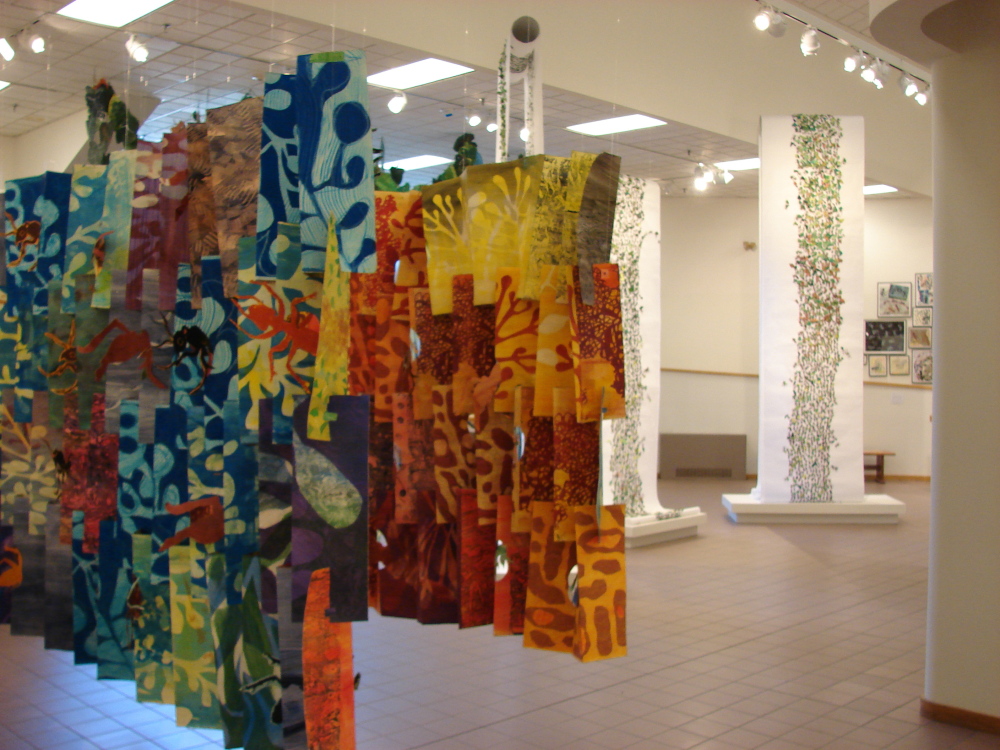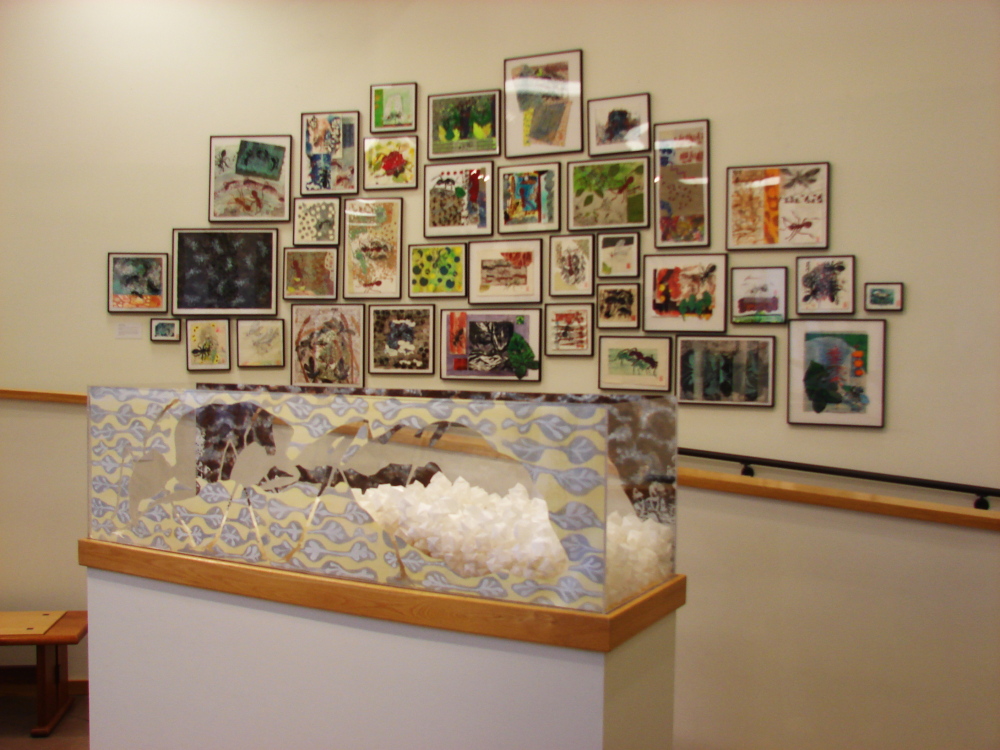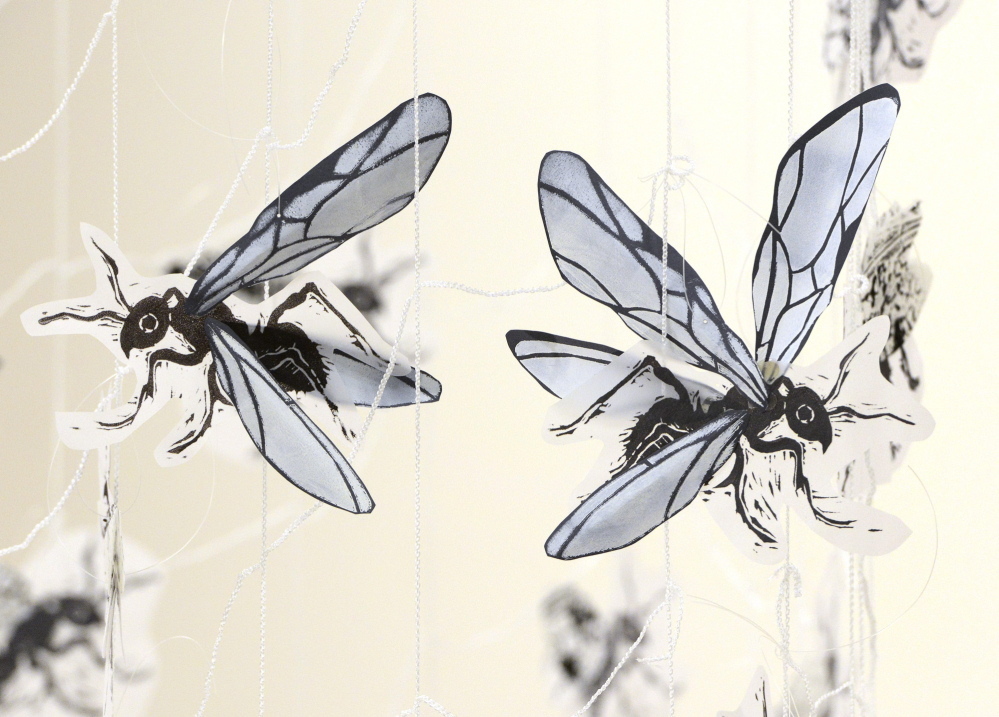The sign for the Atrium Art Gallery at the University of Southern Maine’s Lewiston-Auburn College has been pirated by a large woodcut-printed paper ant so that it now reads “Ant” instead of “Art.” Inside, hang three huge scrolls of white paper covered in many thousands of printed leafcutter ants who, unlike their insurrectionist colleague, are going about their well-organized business of carrying bits of leaves.
The scrolls offer a first glimpse, but it’s immediately clear there is a huge show installed in the gallery.
To the left is a wall of about 30 framed works on paper. To the right is a pair of giant, accordioned hanging paper walls exploding with color. Works of art are everywhere — hanging from the ceiling, mounding up on pedestals and filling vitrines.
Much of the work is thick with pulsing colors while the black forms of ants gather in appealingly rhythmic bunches everywhere throughout the space, from pictures on the wall to a cylindrical web of winged male suitors flying after a queen soaring 20 feet and more above the U-shaped atrium.
“Ant Farm: At the Nexus of Art and Science” is another extraordinary exhibition in the unique flavor of curator Robyn Holman’s shows featuring Maine artists taking on subjects of the natural world. Equal parts art and didactic science, these smart shows move fluently in both directions.
“Art Farm” is a gigantic exhibition both in terms of the number of works and the depth of its content. But despite its symphonic complexity, it’s a fun and welcoming show.
“Ant Farm” was made by a group of Maine artists who call themselves the “Ant Girls” – Dorothy Schwartz, Rebecca Goodale, Vivien Russe and Colleen Kinsella.
Schwartz died of lymphoma in March, just before “Ant Farm” opened in April. She was a beloved artist, professor and leader in the Maine arts scene who was the executive director of the Maine Humanities Council for 25 years. Rather than using “Ant Farm” to remember Schwartz, I think it should be seen for what it is: a great collaborative exhibition. I see “Ant Farm” as Schwartz’s triumph – not her memorial.
Schwartz’s touch sets the tone for “Ant Farm,” with images that reflect the draftsmanship and powerful aesthetic of her teacher, Leonard Baskin, arguably America’s greatest and most emotive printmaker.
That said, the idea of individual authorship of the works quickly dissolves. If you are a contemporary art fan, this might be the most interesting aspect of the show. Our post-war American view of art is so dedicated to the marketing and recognizability of any artist that we have lost the idea of movements and collaborations, the very stuff that made all those “isms” of art so exciting: impressionism, cubism, surrealism, expressionism and so on. It’s unusually interesting here because the society of leafcutter ants creates a complex cultural context for comparison. In fact, leafcutter ant societies are second only to humanity as the most complex animal societies on Earth.
Leafcutter ants live in tropical areas, including in the United States, and are notable for cutting and gathering leaves that they use as nutritional substrates on which they grow their food – a fungus. The ant girls show this alongside mating and communication practices among leafcutters, all of which they present in ways that echo or comment on the creative processes of art in our culture.
In the Surrealist game “exquisite corpse,” artists would fold paper so they couldn’t see the parts of a figure drawn by the other artists, dividing head, torso and lower body. The Ant Girls, in an intriguing meld of architecture, surrealism and “women’s work,” made conjoined drawings on paper and then printed them on sewn patches of fabric treated with cyanotype emulsion (blueprint), creating large pictures of ants that are literal versions of exquisite corpse.
The 40 or so works on the opposite wall were passed from artist to artist until someone decided they were done. It was an apt process for these artists; while they look great together, virtually any of these works is quite excellent on its own.
The show also includes examples of handmade books in a series of vitrines. This is a particularly successful part of the show because these works are so accessible and anyone can imagine handling a book. These reflect a hands-on feel to the pair of hanging walls that are made of folded and notched paper. They are richly printed with Matisse-cutout-inspired tropical imagery featuring cool colors on the outside and warm tones on the inside. The two walls form a sort of tunnel that snakes along parallel to gallery’s long walkway ramp.
An extension of the show features works by each of the separate artists. However, this has the opposite effect from what I expected: Instead of giving us sufficient information to distinguish each artist’s contributions to the collaborations, they underscore that the work cannot be completely parsed.
Another unexpected quality is that the more you learn about leafcutter ant society (by reading the excellent label copy), the more impressive and deep the show becomes – particularly in its modeling of non-verbal social communication.
“Ant Farm” also features a beautiful (in the sense of Alban Berg’s “Wozzek”) soundtrack written and performed by Elliott Schwarz (husband of the late “Deedee”) in collaboration with Caleb Mulkerin and Kinsella.
Hidden in plain view among the exhibition’s deep conceptual insights about collaboration is what amounts to the most ambitious presentation of paper media I have ever seen: sculptures, prints, drawings, scrolls, books, installations, signage, paintings, puppetry, origami and more all brilliantly orchestrated as a single entity somewhere between an exhibition, an installation and a hive.
Because of its heavy pass-through traffic, it’s counterintuitive that the Atrium Art Gallery would routinely mount complex and conceptually challenging exhibitions. But it specializes in such shows, and I have seen none more ambitious or more impressive than “Ant Farm.”
Freelance writer Daniel Kany is an art historian who lives in Cumberland. Contact him at:
dankany@gmail.com
Send questions/comments to the editors.





Success. Please wait for the page to reload. If the page does not reload within 5 seconds, please refresh the page.
Enter your email and password to access comments.
Hi, to comment on stories you must . This profile is in addition to your subscription and website login.
Already have a commenting profile? .
Invalid username/password.
Please check your email to confirm and complete your registration.
Only subscribers are eligible to post comments. Please subscribe or login first for digital access. Here’s why.
Use the form below to reset your password. When you've submitted your account email, we will send an email with a reset code.